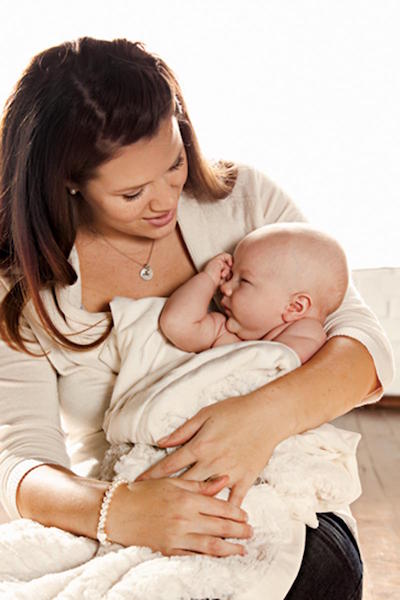The rookie manual
It’s inevitable—even if you’re the oldest of eight kids, started […]

Sound intimidating? It can be, and almost every new mother has panicked at some point along the way, wishing that there were an instruction book with all the answers that came out right along with the afterbirth.
But since that’s not the way Mother Nature works, we’ve put together some essential tips on baby care to help ease your fears and set you up for success.
How to swaddle
Back when you were in the recovery ward, the baby nurses took care of this like baby-swaddling ninjas—one blink of an eye, and your infant was snug as a bug in a hospital-issued rug. But once you go home, there’s no magic button to push for help.
You’ve got to master the wrap on your own.
Follow these simple steps, and you’ll be at ninja status in no time.
Spread your blanket out so one corner of the diamond points toward you.
Fold the farthest corner down and place your baby on top with his head just above the fold.
Wrap one side of the blanket around your baby, tucking the end underneath him.
You can wrap his arms inside the blanket, or leave them free, depending on your preference (or his).
Pull the bottom corner of the blanket (the one closest to you) upwards. Gently tuck it behind the shoulder on the opposite side from where you began wrapping.
Take the remaining piece of blanket, and wrap it around the swaddle, tucking it behind.
Voila—burrito baby!
[tip:] Follow the same steps for an arms-out swaddle; just leave those limbs free to wiggle.

If your tiny person feels feverish or is generally acting unwell, you’re already in worry mode—and then you have to stick what where? Rest assured, it’s not as traumatizing for your baby as you might think. With a little (water-soluble) lubricating jelly and a soothing touch, you’ll both come out of it unscathed.
Technique 1: If your young baby will tolerate the position, lay him face down across your lap with his legs hanging over your thigh. Support his body with one hand and gently insert the thermometer with the other. The thermometer need go in only as far as the instructions on your particular model direct—usually no more than half an inch. (Oh, and by the way, the rectal stimulation may cause your baby to poop, so be forewarned.)
Technique 2: For an older baby who is accustomed to the diaper changing position and will benefit from the distraction of looking at your face, place him on a waterproof surface and raise his legs in the air, holding both with one hand. Insert thermometer as in the first techique. (Goofy expressions and funny noises work well in this scenario.)
[tip:] Wait at least 20 minutes after a bath to get the most accurate temperature reading from your baby.
If an infant under the age of 3 months has a fever of over 100.4












